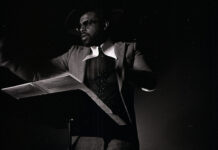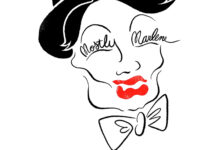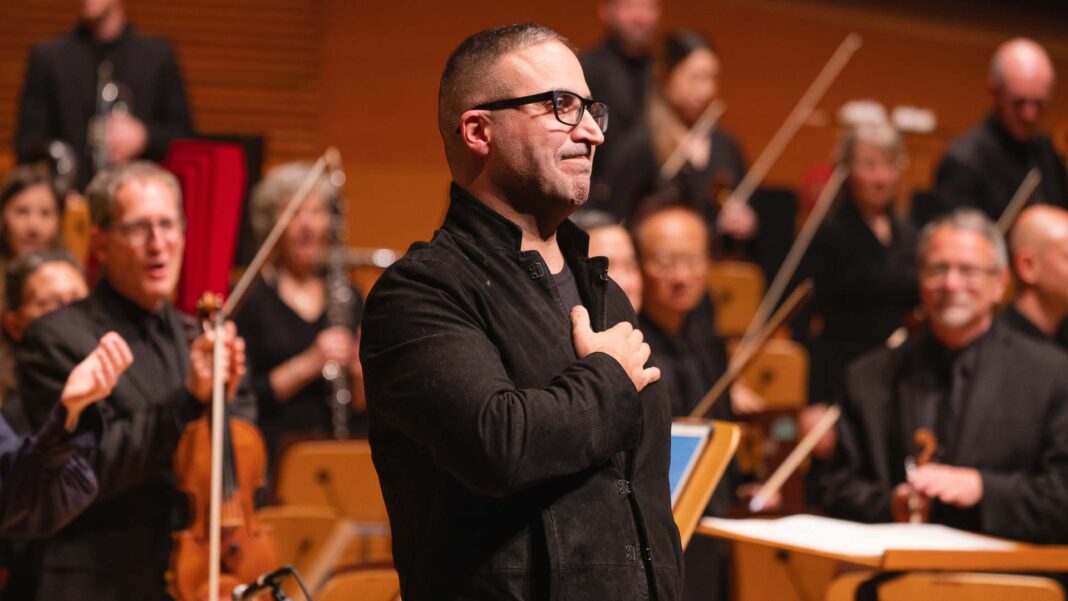Two friends of composer Felipe Lara came to visit him to see his then newborn daughter. He couldn’t join them afterwards, but flautist Claire Chase (for whom Lara has composed several pieces) and double bass player/vocalist esperanza spalding went out without him. While together they decided it would be great if Lara could compose a work for the two of them to do together.
The end result is Lara’s Double Concerto which had its world premiere with the Helsinki Philharmonic last fall. This past week Chase, spalding and conductor Susanna Mälkki reunited to perform the work with the Los Angeles Philharmonic (who co-commissioned the work with the Helsinki Philharmonic.)
On Wednesday, March 29th, the trio will once again come together for three performances of the Double Concerto with the New York Philharmonic.
Last week, just hours before the US premiere of his concerto in Los Angeles, Lara and I spoke about the work, the two women for whom he wrote it and whether, given their talent, if this is truly a quadruple concerto instead of just a Double Concerto. What follows are excerpts from our conversation that have been edited for length and clarity. To see the full interview, please go to our YouTube channel.
In a video interview for Helsinki Philharmonic, you said “the moment things become impossible is the moment things become exciting to try something.” What was that first moment where it all seemed impossible and it switched to become exciting for this particular work?
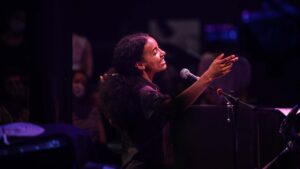
I got a call asking if I could write a concerto for the two of them. It just seemed such like a strange idea to me – the contra pizzicato concert bass and the flutes – the two most fragile things in the world. But then the way they played out is not fragile at all. So I just did it.
There’s something not so intimate about the orchestra. This is this massive thing. The moment that it became barely possible to do and to even think about anything like that, it became like an interesting challenge. What does it means to improvise in the context of an orchestra? There’s nothing that could be more further from the idea of a symphony orchestra than improvisation.
I wrote a piece for these two. It’s not a piece for bass; no one can play bass and sing like esperanza. Who can play all those flutes like Clare and also sings? It is also has a singing part blended with the flute. The minute that they stop playing the piece it’s gone, which I completely accept.
Does fragility itself as a concept play a role in the piece itself since you have these two great expressions of fragility on stage, front and center?
I knew that I wanted to do a piece for amplified soloists, so I did not really want to be walking on eggshells. Even if I would write without amplification, I’m not super keen on concerti that is like here’s the soloist and now here’s the orchestra; this back and forth / question and answer. This is one scenario [where] there’s nothing wrong with overwhelming the soloist and having it emerge from from that dust and having a more dynamic interaction between the two. So for this amplification it’s not just for balance sake. I wanted this intimate orchestra of amplified, very closed miked sounds to become their own little pocket orchestra in which they could interact with the bigger orchestra. So it’s not that fragile in the end.
What was the process of working with Claire and esperanza and how did that evolve during the process of composition?
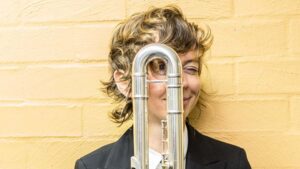
Collaboration is a huge thing for me. It doesn’t have to just happen in the beginning, it can happen in the middle. We can adjust things. Nothing is really set in stone. In fact, for this performance, I wrote a whole new little link between the fully-improvised part of the cadenza linking between that and the return of the orchestra. It’s a dangerous thing to be improvising and then try to get the orchestra of 100 people back together at the same time. So I wrote something to bring them back.
This improvisation was one of the key things of the piece. I wanted to attempt this piece that you really didn’t know what was improvised and what was written. This dance of oral music traditions and written music traditions and to make what might seem impossible with the possible. How could improvised music be the same as this very specific written kind of fixed notes and rhythms on a page. That was constantly on my mind.
Would you like to see this recorded? And would it be best to have this recorded live at a concert given its improvisational elements or something better done in a proper studio?
That’s a great question. Well, the answer to the answer to the first question is yes, I would absolutely like to have this recorded. It would be nice to capture as a documentation, like a well-recorded documentation with many mics and so forth. That is not on the horizon at the moment. I would like for it to be. It would be a picture. Like a snapshot of one version of the spirit of that piece. I’ll be perfectly happy with that.
What precludes you from calling this a triple concerto? esperanza’s vocals are omnipresent throughout the piece. I know Claire has her moments, but it feels like this is a concerto for at least three instruments not just two.
You’re right. But it would be then actually a quadruple concerto. Claire’s voice is really a big part of this. It’s not always amplified or perceived by itself, but is often modulating the sound of the flute.
Probably not that my catchiest name, the Double Concerto, but you know, these titles are strange things. Sometimes they come early, sometimes they come late, sometimes they have a very specific title before you even have the piece. In this case it was just late in the game. It’s still a double for two people. It’s a dual in that sense. This idea of the soloist – it’s an interesting one. When I write music for solo instruments, I try to really explore that that instrument, whatever it might be.
In a video that Claire and esperanza did with the Helsinki Philharmonic, esperanza talked with this great sense of wonder about what she called “The accumulation of human devotion found in a symphony orchestra.” I thought that was a really beautiful way of expressing the humanity that is on that stage, not just the talent behind it. As somebody who writes for that accumulation of humanity and how it can express itself, how does that same accumulation, required to perform any music, inspire you as a composer so that you can trust them to express what it is you want when they’re on stage performing your music?
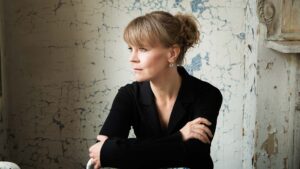
A lot of love and care comes in every note. In every day’s work. Thinking very carefully about each sound and taking risks, but trying to calculate the risks and having humans in mind. Having strategies to achieve things exactly how I want to achieve [them] without necessarily frustrating musicians and maybe freaking them out too much.
In the orchestra you get this enormous palette of sound and this enormous force and dynamic range. Here there’s two orchestras. It looks like an enormous orchestra, but is really two Mozart-sized orchestras put together and somewhat separated on stage. One is tuned a quarter tone away from the other. So when I want my quarter tone notes I go to one group. When I want the the the chromatic note they go to the other, but together it just works out. I’m thinking of how can I do my job and own these sounds, no matter how big a risk I take.
I’m trying to push things forward, not necessarily reinventing the wheel, but it’s a constant effort of trying to expand things and finding the next plateau. I’m not necessarily thinking historically in that sense, but I definitely think what’s the next thing I should be trying to do that I can’t do yet.
I think it’s a very necessary and healthy thing to do. It might be frustrating at times. But ten, 20 years, you really feel the growth of the things that you are trying to try to do and being comfortable with the unknown. Being comfortable with being uncomfortable. It’s a good thing for a composer.
To see our full interview with Felipe Lara, please go here.
Main Photo: Composer Felipe Lara (Photo by Farah Sosa/Courtesy LA Philharmonic)


